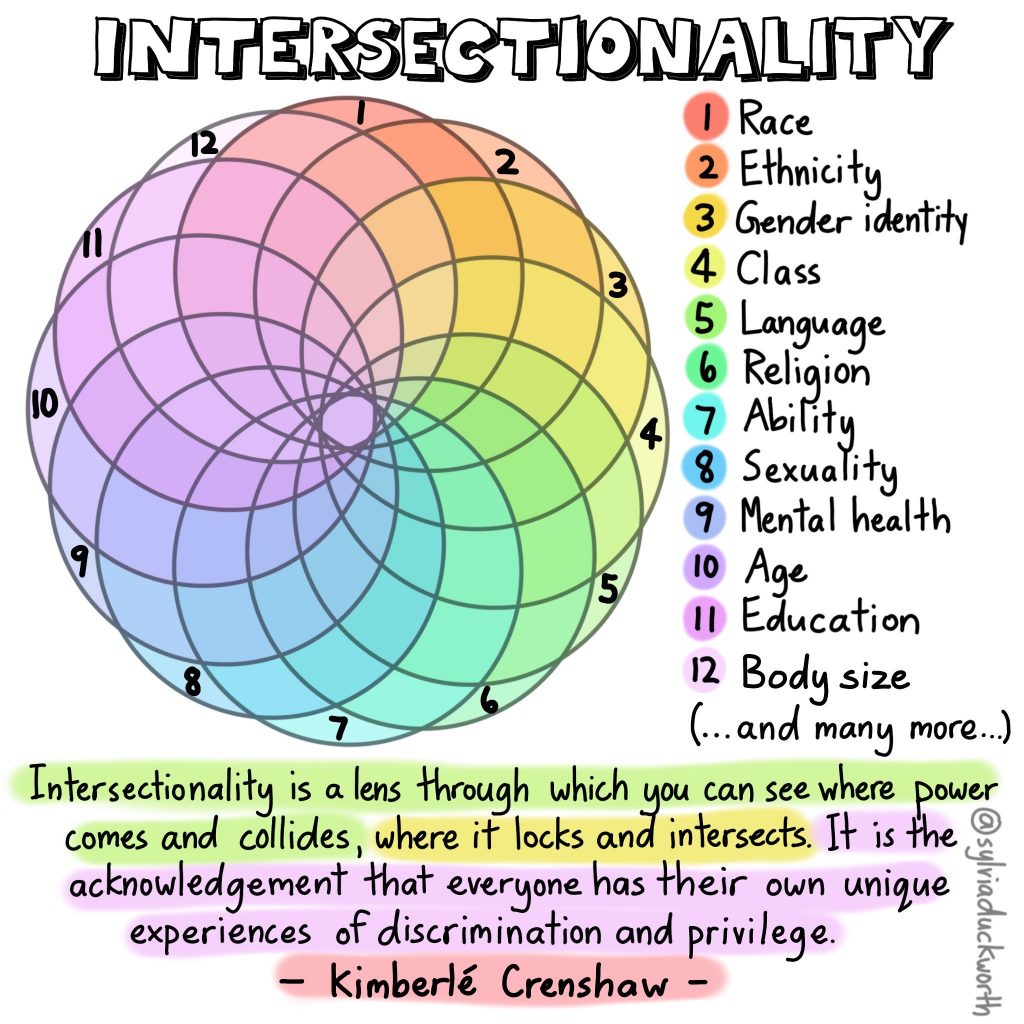4.2: Positionality and Intersectionality
Now that you have spent some time reflecting on equity, diversity, and inclusion, let’s dive a bit deeper into how our social identities, positionality, and privilege(s) intersect.
Positionality
Positionality refers to the personal values, views, and location in time and space that influence how one engages with and understands the world. It is wrapped up in the dynamics of power and privilege. For example, your gender, race, class, and other aspects of your social identities influence and inform how you move through the world, what knowledge you produce and value, and the biases through which everything you say, think, and do, is filtered, intentionally or otherwise.
Moreover, positionality is experienced differently in different contexts, and can dictate how much access you have (to resources, support, etc.) in society (The University of British Columbia, n.d.). In this sense, we cannot ignore “the power inherent in . . . social positions” (Misawa, 2010, p. 26).
Intersectionality
In this video, What is Intersectionality? [1:54] by the National Association of Independent Schools (2018), Professor Kimberlé Crenshaw talks about the study of how overlapping or intersecting social identities relate to systems and structures of discrimination.
Related to positionality, intersectionality acknowledges the complex relationship between social identities, and systems of power and oppression. Given the fluid, relational, and social construction of identities, intersectional paradigms recognize that every person has multiple and diverse identities (e.g., race, gender, sexual orientation, socio-economic status, dis/ability, beliefs, and worldview) that combine in unique ways to shape our perspectives, and experiences with oppression and privilege (Ontario Human Rights Commission, 2001). In this context, intersectionality recognizes that oppression does not exist within a vacuum, but rather intersecting oppressions work together in producing injustice (Collins, 2001).
The following graphic entitled “Intersectionality” visually displays how social identities intersect with one another and are wrapped in systems of power. For example, using the imagery of a spirograph, Duckworth (2020) colour-codes various social identities including race, ethnicity, gender identity, class, language, religion, ability, sexuality, mental health, age, education, and body size.


Social Identities, Privilege and Oppression
Critical social psychology describes identity as a social construction that is learned through interactions with others and the world, and that has a strong impact on who we become (Allen & Rosatto, as cited in Shah, 2018). Social privilege exists on the basis of complex and intersecting social identities, such as race, gender, ability, class, faith/religion, age and sexuality and the relative distance of these identities to dominant identities and power (Black & Stone, as cited in Shah, 2018).
Wheel of Power/Privilege
Sylvia Duckworth’s “wheel of power/privilege” is another visual representation of how power, privilege, and social identities intersect. The graphic below uses the imagery of a wheel, sectioned off by the following social identities and respective categories:
- Citizenship: citizen, documented, undocumented
- Skin colour: white, different shades, dark
- Formal education: post-secondary, high school, elementary
- Ability: able-bodied, some disability, significant disability
- Sexuality: heterosexual; gay men; lesbian, bi, pan, asexual
- Neurodiversity: neurotypical, neuroatypical, significant neurodivergence
- Mental health: robust, mostly stable, vulnerable
- Body size: slim, average, large
- Housing: owns property, sheltered/renting, homeless
- Wealth: rich, middle class, poor
- Language: English, Learned English, non-English monolingual
- Gender: cisgender man; cisgender woman; trans, intersex, nonbinary


Activity 2: Define Yourself
In this topic, we hope you learned about yourself, your salient social identities, and how they interact with the systems of power and oppression in our society. To conclude, we invite you to think about your social location and the intersecting identities which shape your interactions within the higher education system. How are these similar and different to your colleagues, students, and administrators? How has academia epistemically favoured scholarship and ways of knowing of those with identities closer to the centre of power? Which social identities do the systems of power historically (and currently) serve?
Referring back to the identities in the Wheel of Power/Privilege think about how you define yourself, and where your salient social identities are located on the wheel. Get curious about:
- How close or far away from the centre are you?
- How does your level of power shift as you place yourself in different identity categories?
- Thinking about your institution, where do students, staff, administrators, and/or faculty reside?
You are invited to record your reflection in the way that works best for you, which may include writing, drawing, creating an audio or video file, mind map or any other method that will allow you to document your ideas and refine them at the end of this module.
Alternatively, a text-based note-taking space is provided below. Any notes you take here remain entirely confidential and visible only to you. Use this space as you wish to keep track of your thoughts, learning, and activity responses. Download a text copy of your notes before moving on to the next page of the module to ensure you don’t lose any of your work!
References
Collins, P. H. (2001). Black feminist thought: Knowledge, consciousness, and the politics of empowerment. New York: Routledge.
Duckworth, S. (2020, Aug 19). Intersectionality [Infographic]. Flickr. https://flic.kr/p/2jy46K4. CC BY-NC-ND 2.0.
Duckworth, S. (2020, Oct 18). Wheel of power/privilege [Infographic]. Flickr. https://flic.kr/p/2jWxeGG. CC BY-NC-ND 2.0.
Misawa, M. (2010). Queer race pedagogy for educators in higher education: Dealing with power dynamics and positionality of LGBTQ students of color. International Journal of Critical Pedagogy, 3(1), 26-35. http://libjournal.uncg.edu/ijcp/article/view/68
National Association of Independent Schools (NAIS). (2018, Jun 22). Kimberlé Crenshaw: What is intersectionality? [Video]. YouTube. https://youtu.be/ViDtnfQ9FHc
Ontario Human Rights Commission. (2001). An introduction to the intersectional approach. http://www.ohrc.on.ca/en/intersectional-approach-discrimination-addressing-multiple-grounds-human-rights-claims/introduction-intersectional-approach
Shah, V. (2018). Leadership for social justice through the lens of self-identified, racially and other-privileged leaders. Journal of Global Citizenship & Equity Education, 6(1). https://journals.sfu.ca/jgcee/index.php/jgcee/article/view/168/399
The University of British Columbia. (n.d.). Positionality & Intersectionality. https://indigenousinitiatives.ctlt.ubc.ca/classroom-climate/positionality-and-intersectionality/

